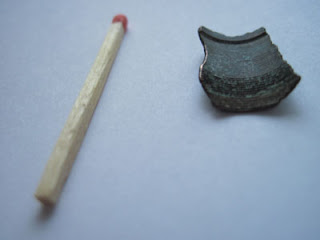I was given a metal detector as a birthday present back in December and have only just got round to using it. The first trial was on the pebbly beach near home with my daughter Jill. We found a small piece of metal which I am nearly sure is copper or brass. It is curved and on its inner surface has what appears to be a very fine thread. The piece itself appears to be a fragment of something larger.
The next item was found a couple of years ago, and those in the know will instantly recognise the top of a trigpoint. But what is the strange object attached to a sealed sort of karabiner fixed to a metal bar embedded in the concrete of the trig? It may not be too evident in the pic but there are some sharp spikes sticking upwards on the end of the bottom arm.
The location of the trig was near Calf Holes above Horton in Ribblesdale GR – SD 804 778.
I look forward to some answers!




It's a long long time since I went orienteering (1984, to be precise), but that thing on the trig-point looks just like how I recall the punches on the orienteering route to have looked.
ReplyDeleteEach station on the route (I'm sure 'station' isn't the correct term, but I can't think what they are called) had a punch with a different pattern of pins.
Competition. There isn't enough of it but if it is copper or brass then its application was surely marine. Both copper and brass are quite valuable as scrap and that's why you don't see too much of either kicking about on land. However the fine screw thread seems to suggest otherwise; marine artefacts (like winches for instance) tend to have coarse-ish but deep threads. The alternative would be an electrical component and the shape hints at an insulator even if the metallurgy suggests conduction.
ReplyDeleteI cannot begin to answer about the thing on the trig point, but I think the other is a fragment of a brass coupler - whether for plumbing or something else, I don't know. The threads attach to a threaded pipe and the groove along the other end looks like it covers and secures a flange of some sort, perhaps a rotating washer, maybe?
ReplyDeleteIt also looks as if it were broken by explosive force - perhaps a steam pipe fitting? Did the waters in that area see much ship traffic in WW2? (I don't know where you are, exactly, Sir Hugh, so please excuse what might be a dumb question.)
I realize I'm making a lot of guesses, but perhaps it was once part of an adjustable nozzle for a water hose?
Curiouser and curiouser, said Alice...
I'm with Gayle - certainly looks like an orienteering punch
ReplyDeleteAll – thanks for the comments.
ReplyDeleteThe trig point thing. If this is an orienteering device, and I cannot think of anything else it could be, it seems to be over elaborate. Why would what I believe to be a fairly sparsely funded sport have a tailor made expensive item like this, and then go to the trouble of sinking an iron bar into the top of a trig point, possibly with legal issues involving the OS? I suppose the answer to that would be that this would be an unmanned checkpoint necessitating a method of registering a visit that was vandal proof.
Welcome to new commenter PhilW. I am not acquainted with your background, but if much of it relates to orienteering I value your comment. I have never taken part in that sport.
The brass shard. To me this looks like some part of a precision instrument – very small telescope, sextant, microscope or the like. I go along with BB up to a point but I’m not so sure about the electrical component, but I bow to his RAF education on this point. I am in accord with the observant Crow in that it appears to be something that has been fragmented by force rather than erosion, and that really sets the imagination going.
Hello Sir Hugh. Mainly a walker myself, though I have done a very little bit of orienteering in the past, which is why I identified the punch as such.
ReplyDeleteIt looks quite old and I suspect it has been attached in such a way to make sure nobody nicks it!
Glad to see the meatal detector working,remember the 10% rule.
ReplyDeleteLWAOKOIPUT - Mmm?
ReplyDelete